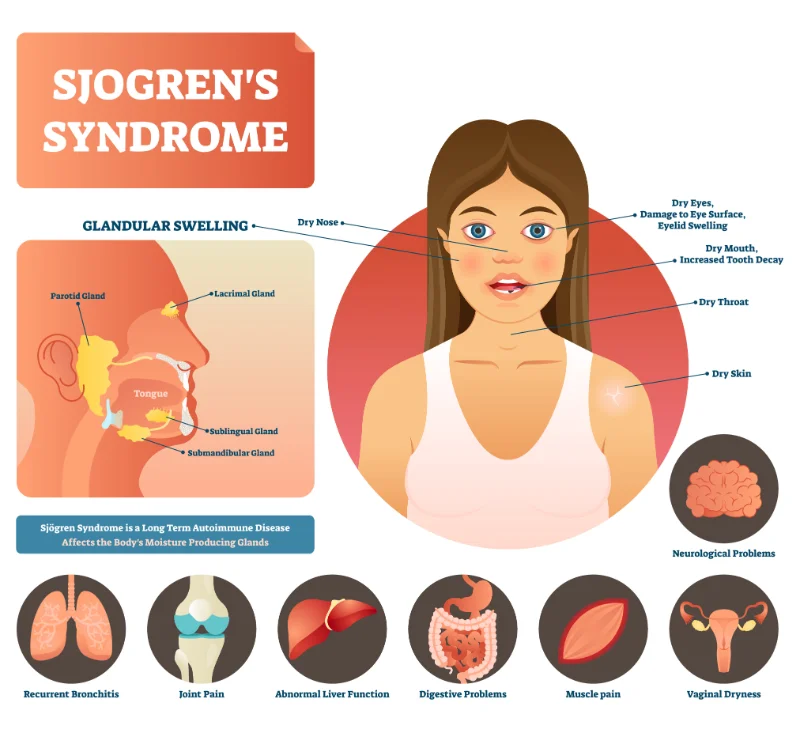Sjogren’s Syndrome: The Facts You Need to Know
Sjogren’s (SHOW -grins) syndrome, a chronic autoimmune disease, affects millions of people worldwide. It primarily targets the exocrine glands, leading to dryness of the mouth and eyes, among other manifestations. This systemic autoimmune disease not only affects the quality of life of patients but also poses long-term health risks. In this blog, we will delve into the various aspects of Sjogren’s Syndrome, including its definition, symptoms, diagnosis, treatment options, and recent advancements in research. Understanding this condition is crucial for early diagnosis, appropriate management, and improved outcomes for patients.
Understanding Sjogren’s Syndrome
Sjogren’s syndrome is a complex autoimmune disease that primarily affects exocrine glands, responsible for producing saliva and tears. The disease is characterized by lymphocytic infiltration, wherein immune cells, especially B cells, infiltrate the salivary and lachrymal glands of patients, causing damage and reduced glandular function. The classification criteria provided by the European League Against Rheumatism help diagnose this condition.

What is Sjogren’s Syndrome?
Sjogren’s Syndrome leads to dryness of the mouth and eyes, which are among the most common symptoms of this disease. There are two types of Sjogren’s syndrome: primary Sjogren’s syndrome (pSS) and secondary Sjogren’s syndrome (sSS). In pSS, the condition exists alone without any accompanying autoimmune diseases. In pSS and sSS, being that this disease primarily affects the exocrine glands which are essential for maintaining the moisture of mucous membranes, such as those in the mouth, eyes, and respiratory tract, when the immune system mistakenly attacks healthy tissue, it leads to chronic inflammation and dysfunction of the exocrine glands. In sSS, patients experience symptoms of Sjogren’s syndrome along with another autoimmune disease, such as rheumatoid arthritis or systemic lupus erythematosus. It is important to distinguish primary Sjogren syndrome (pSS) from secondary Sjogren syndrome (sSS) as the treatment and management strategies may differ based on the underlying autoimmune condition.
Common Symptoms of Sjogren’s Syndrome
The hallmark symptoms of Sjogren’s syndrome revolve around dryness of the mouth, eyes, and other mucous membranes. Dry eye, medically known as keratoconjunctivitis sicca, occurs when the lachrymal glands fail to produce enough tears, leading to eye irritation, redness, and a gritty sensation. Dry mouth, also called xerostomia, results from the reduced production of saliva by the salivary glands. This dryness can make it difficult to speak, swallow, and even taste food.
In addition to dryness, patients with Sjogren’s syndrome may experience systemic manifestations, including fatigue, joint pain, and muscle aches. Respiratory symptoms, such as chronic cough and a hoarse voice, may develop due to dryness of the respiratory tract. Gastrointestinal symptoms, such as difficulty swallowing, acid reflux, and abdominal pain, can also impair patients’ ability to eat and digest food.
It’s important to note that Sjogren’s syndrome is not limited to dryness alone. Many patients experience neurological symptoms, including neuropathic pain, cognitive impairment, and difficulty concentrating, which can significantly impact daily functioning. Furthermore, Sjogren’s syndrome patients have an increased risk of developing lymphoma, a type of cancer, as well as other organ involvement, such as skin, renal, and hepatic manifestations.

The Debilitating Nature of Sjogren’s Syndrome
The debilitating nature of Sjogren’s syndrome impacts patients in various facets of their lives. From the challenge of dry eyes and mouth due to decreased secretion from the salivary and lacrimal glands, to the systemic features like fatigue, joint pain, and internal organ involvement, this condition greatly affects the quality of life for SS patients. Studies have shown that early diagnosis is crucial in providing appropriate medical assistance and preventing severe complications. Additionally, the impact of Sjogren’s syndrome is not limited to physical health, as it can also have a significant effect on the mental and emotional well-being of individuals.
Impact on Daily Life
Living with Sjogren’s syndrome can be challenging on a daily basis. Here are 10 facts you need to know about this condition:
- The constant fatigue, joint pain, and muscle aches can make even simple tasks difficult.
- Dryness of the eyes, mouth, and respiratory tract can cause discomfort and affect communication.
- Gastrointestinal symptoms may lead to difficulties in eating and digestion.
- Neurological symptoms such as neuropathic pain and cognitive impairment can impact daily functioning and concentration.
- Sjogren’s syndrome is an autoimmune disorder that primarily affects the exocrine glands, resulting in decreased secretion of fluids.
- It is more common in women than men, and typically develops in middle age.
- Sjogren’s syndrome is often associated with other autoimmune disorders such as rheumatoid arthritis and lupus.
- There is no cure for Sjogren’s syndrome, but treatment options are available to manage symptoms and improve quality of life.
- Individuals with Sjogren’s syndrome have an increased risk of developing lymphoma and other organ involvement.
- Early diagnosis and appropriate medical assistance are crucial for managing Sjogren’s syndrome and improving quality of life.

Long-Term Health Risks
Long-term implications of Sjogren’s syndrome involve pulmonary, renal, and neurological manifestations, posing a risk to patients’ overall health. Individuals with Sjogren’s syndrome are at an elevated risk of developing lymphoma, a concerning long-term complication. The systemic autoimmune disease is known for causing tissue damage, emphasizing the need for early diagnosis and appropriate medical assistance. Moreover, Sicca syndrome, characterized by dryness of mucous membranes, can lead to chronic obstructive pulmonary disease, especially in older patients. This not only affects the salivary glands of patients but also significantly impairs their quality of life. Therefore, understanding the long-term risks associated with Sjogren’s syndrome is crucial for ensuring the well-being of affected individuals.
Diagnosing Sjogren’s Syndrome
Early diagnosis of Sjogren’s syndrome is crucial for appropriate medical assistance. The diagnosis of primary SS patients involves focusing on different parameters, such as the mean age, tear film, and keratoconjunctivitis sicca, among others. Studies have shown that a systematic review of the salivary glands of patients has led to significant improvement in the diagnosis of pSS. Furthermore, the focus score and B cells play a vital role in the diagnosis of SS. In respect of any healthcare, diagnosing SS in older patients, including older adults, requires careful consideration of the specific symptoms, such as ocular surface issues. The aim of this study is to highlight the significance of early diagnosis and prompt intervention, especially in cases of emergency.

Medical History and Physical Examination
Evaluating clinical manifestations is crucial in diagnosing Sjogren’s syndrome. Physicians carefully assess dry eye, dry mouth, and systemic autoimmune disease manifestations to identify the condition. Age, gender, and previous medical history play significant roles in the diagnosis process, especially in considering connective tissue disease and systemic manifestations. Preliminary study findings are utilized by physicians to guide the diagnosis and treatment of Sjogren’s syndrome, ensuring appropriate medical assistance for patients. Additionally, early diagnosis is essential as it leads to significant improvement in the management of the condition, making it imperative for healthcare professionals to focus on these aspects during the medical history and physical examination of patients.
Lab Tests and Imaging Studies
Lab Tests and Imaging Studies play a crucial role in the diagnosis of Sjogren’s syndrome. These diagnostic procedures focus on several aspects such as autoantibodies, salivary gland function, and ocular dryness. Connective tissue disease markers including anti-SSA and anti-SSB are evaluated to identify potential indicators of the syndrome. In addition, procedures like salivary gland biopsy, lip biopsy, and minor salivary gland biopsy are conducted to gather essential diagnostic insights. Furthermore, techniques such as magnetic resonance sialography and salivary gland scintigraphy contribute significantly to confirming the diagnosis. Diagnostic ultrasound is also utilized to visualize any abnormalities in the salivary glands, further aiding in the assessment of Sjogren’s syndrome.

Treatment Options for Sjogren’s Syndrome
Patients with Sjogren’s Syndrome, especially those with severe complications, may require a combination of treatments to manage symptoms effectively. Here are some treatment options that may be prescribed:
- Over-the-counter tear substitutes to relieve dry eyes
- Prescription eye drops to reduce inflammation in the eyes
- Saliva substitutes to relieve dry mouth
- Medications to control joint pain and inflammation
- Immunosuppressive drugs or disease-modifying antirheumatic drugs (DMARDs) to suppress the immune system’s attack on healthy tissues
- Biological therapies, such as rituximab, to target specific B cells and benefit Sjogren’s patients.
It’s important to work with your healthcare provider to find the right combination of treatments for your individual needs.
Research into potential new treatments and therapies, including stem cell therapy and gene therapy, holds promise for the future. However, it’s essential for patients to consult with healthcare providers to determine the most appropriate medical assistance in respect of their individual needs.

When picking a Saliva Substitute
When picking a saliva substitute for Sjogren’s Syndrome, it is important to consider the following factors:
- Look for a product that provides long-lasting relief and contains Hyaluronic acid, known to have lubricating and moisturizing properties like human saliva.
- Choose a saliva substitute that does not contain irritants or allergens that may worsen symptoms. Try something that is flavorless and fragrance-free to alleviate the symptoms of dry mouth, and watch out for flavors that may cause burning or irritate the oral cavity
- Look for a product that contains xylitol known to reduce the risk of cavities and tastes sweet like sugar but, unlike sugar, it will not cause tooth decay.
- Consider the form of the product (gel, spray, lozenge) that is most convenient and comfortable for you to use.
Remember to always consult with your healthcare provider before starting any new treatment or medication.
Medication for Symptom Management
In managing symptoms of Sjogren’s syndrome, nonsteroidal anti-inflammatory drugs (NSAIDs) can effectively address joint pain and swelling. Similarly, dry mouth can be alleviated using saliva substitutes like
Lubricity Oral Spray for a flavorless and 5 – natural ingredients option, while
Lubricity Xtra has a strawberry option if you prefer a flavor. We had some Sjogren’s clients try the strawberry flavor and liked it. To manage your dry eyes, you can find relief through eye drops and ointments. In more severe cases, healthcare providers may prescribe immunosuppressants to manage the symptoms effectively. It is crucial for SS patients to work closely with their healthcare providers to determine the most appropriate medication plan tailored to their individual needs and condition, ensuring significant improvement in their quality of life.

Therapies for Severe Cases
In severe cases of Sjogren’s Syndrome, different therapies may be employed to manage the condition and prevent further damage to the organs. Immunosuppressive therapy, including corticosteroids, can effectively reduce inflammation and halt organ damage by suppressing the immune system. Biologic therapies target specific immune cells responsible for damaging the body, offering a more precise approach to treatment. Additionally, procedures such as plasma exchange help remove harmful antibodies from the patient’s blood, improving symptoms and preventing organ damage. Intravenous immunoglobulin (IVIG) infusions aid in regulating the immune system and reducing inflammation. For severe, life-threatening complications, a stem cell transplant may reset the immune system and prevent further damage, although it is typically reserved for such critical cases.
Living with Sjogren’s Syndrome
Living with Sjogren’s Syndrome can impact multiple aspects of daily life. From managing dry eyes (keratoconjunctivitis sicca) and a dry mouth (xerostomia) to coping with systemic symptoms, patients face various challenges. Additionally, older adults are more commonly affected, and timely diagnosis is crucial for appropriate medical assistance. This includes understanding the systemic involvement of primary Sjögren’s syndrome (pSS), which affects not only the exocrine glands but also other organs such as the kidneys, lungs, liver, and nervous system. The study group focuses on different parameters to ensure an early diagnosis of pSS and significant improvement in its management, aiming to provide better control of symptoms and quality of life for SS patients.
Lifestyle Modifications
Incorporating dietary adjustments, staying well-hydrated, and identifying triggers can be advantageous for individuals with Sjogren’s syndrome. It is essential for patients to maintain good oral hygiene to prevent dental complications. Furthermore, prioritizing sufficient rest, effective stress management, and engaging in regular physical activity contribute to overall well-being. Adapting daily schedules to conserve energy is crucial in coping with fatigue, a common symptom of the condition. Empowering oneself with knowledge about the disease enables informed decision-making and better management of the condition.

Support and Resources
Seeking emotional support, whether from close social circles or trained professionals, is crucial for individuals dealing with Sjogren’s syndrome. Joining specialized support groups and connecting with others facing similar challenges can provide a sense of community and understanding. Educational resources like informational websites, books, and reputable medical journals offer valuable insights into the condition, empowering patients to make informed decisions about their health. Exploring financial assistance, disability accommodations, and legal rights is essential for ensuring access to necessary support. Engaging with advocacy organizations can also provide access to helpful resources and information, facilitating a more comprehensive approach to managing the impacts of Sjogren’s syndrome.
Recent Developments in Sjogren’s Syndrome Research
Recent Research in Sjogren’s Syndrome has focused on diverse parameters including the ocular surface, salivary glands of patients, and B cells. Studies have highlighted significant improvement in the diagnosis of primary Sjogren’s (pSS) with a focus on early diagnosis and appropriate medical assistance. A systematic review revealed a mean age range of affected individuals and the prevalence of pSS patients among older adults. Additionally, research emphasized the importance of differentiating pSS from cases of emergency, such as keratoconjunctivitis sicca, and the need for respect of any healthcare protocols. The aim of this study was to ascertain the confidence interval for diagnosing pSS and its distinction from related conditions like multiple sclerosis. The findings also underscored the necessity for tailored diagnostic approaches and treatments specific to Sjogren’s syndrome patients.

Novel Treatment Approaches
Novel approaches to treating Sjogren’s syndrome are continuously being explored, with a focus on emerging treatments like biologics that show promise in managing disease activity. Targeted therapies are also being developed to address specific immune system pathways involved in the disease, offering new hope for SS patients. Additionally, clinical trials evaluating new medications and interventions are currently underway, paving the way for potential breakthroughs in treatment. Innovative approaches such as gene therapy are also being explored for future use, showcasing the relentless effort to find effective solutions for those affected by Sjogren’s syndrome. Furthermore, collaborations between researchers, healthcare providers, and patients play a crucial role in driving progress and ensuring that novel treatment approaches are thoroughly researched and developed to benefit SS patients.
How Can Patients Participate in Sjogren’s Syndrome Research?
Patients can actively contribute to Sjogren’s syndrome research by participating in clinical trials and studies, sharing personal experiences with researchers, advocating for increased funding and support, engaging with patient advocacy groups, and staying informed about research developments.
Conclusion
In conclusion, it is important to understand that Sjogren’s Syndrome is a chronic autoimmune disorder that affects various aspects of one’s life. From the daily challenges to long-term health risks, individuals with Sjogren’s Syndrome require proper medical attention and support. Diagnosing the condition involves a combination of medical history, physical examination, and lab tests. Treatment options include medication for symptom management and therapies for severe cases. Living with Sjogren’s Syndrome requires lifestyle modifications and access to support and resources. It is also encouraging to note that there have been recent developments in Sjogren’s Syndrome research, leading to novel treatment approaches. Patients can actively participate in research to contribute to advancements in understanding and managing this condition.












One reply on “Understanding Sjogren’s Syndrome: Essential Facts”
This seems like a product that would be ideal for the cannabis industry that get cottonmouth all the time